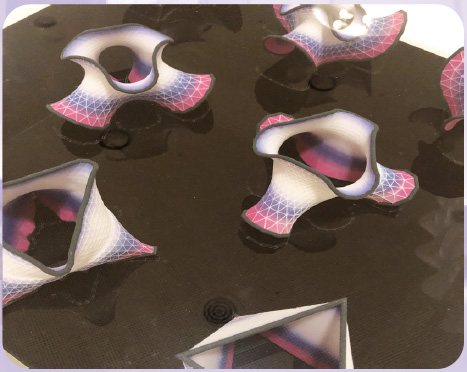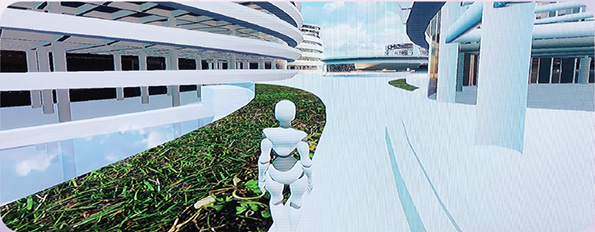
Until a few years ago, people did not imagine that they would easily communicate with others and create something through a virtual space called Metaverse. Also if they dared to imagine it, they couldn’t have certainty that it would ever be practically possible. However, now, this phenomenon that people considered to be impossible is unfolding before my very eyes. What will the world face in industry and society that develops and changes in an unpredictable direction in the future? At the Design Museum in Dongdaemun Design Plaza, Zaha Hadid Architects shows their unique works and visions. For those who are not satisfied with existing classics and crave for innovative new things, ZHA provides the opportunity to feel the future that they will change and the other has already arrived in the people’s hands.
Zaha Hadid Architects (ZHA) was finally selected as the winner in the previous Dongdaemun Digital Plaza (DDP) building design contest. Therefore, the current DDP building was built according to a design submitted by ZHA at the time, and has had a deep connection with DDP since then. The Seoul Design Foundation (SDF), who planned the exhibition, leaves visitors with the message of “innovation of design through heterogeneous fusions and its application to solve social issues and create a better future.”
[Meta-Horizons: The Future Now]
The exhibition is held in the Design Museum, on the 2nd floor of Dongdaemun Design Plaza (DDP) in Seoul. DDP is located in close proximity to a subway station, so it is easy to access by public transportation. The exhibition runs from the 26th of May to the 18th of September, and tickets can be booked either online or at the ticket office located on the 1st floor of DDP Design Museum. The museum is open from 10 AM to 8 PM, and it takes about an hour on average, to see the whole exhibition. If anyone is interested they should definitely visit and experience the exhibition. Be advised, however, that booking tickets and entrance to the exhibition hall ends at 7 PM, an hour before the closing time. It will also be closed on the day of Chuseok during the upcoming September holiday.
This exhibition has been designed to seek the new possibility of future design through the process of exploring and collaborating across past and present, virtual and existential and genre and boundaries. The exhibition has 3 sections, ‘INNOVATION – Process & Research,’ ‘IMAGINATION – Design & Virtual’ and ‘INTERACTION – Technologies & Collaboration.’ Visitors can experience pieces of ZHA, using computer digital techniques, eco-friendly and sustainable architecture, design using artificial intelligence and utilization of VR technology as well as the collaboration of work with media art. There are arrows that visitors can follow to guide them through the exhibition, but the direction of the arrows is a bit unclear and hard to follow. Therefore, it would be better to carefully check the titles of each section. Also, if the posted explanation for each piece is not clear enough to understand, a free audio guide is provided in both Korean and English. A CBT reporter recommends taking the audio guide while watching the exhibition. Each work is numbered, making it quite easy to follow the audio guide.
The exhibition is organized around 3 big subjects, ‘innovation, imagination and interaction,’ and shows works that are not only limited in artistic value, but also the cooperation with various fields that the Zaha Hadid Architects shows.
[INNOVATION – Process & Research]
The first part of the exhibitions is ‘innovation.’ The innovation that ZHA pursue is creating new things that hasn’t existed before through the collaboration with other branches of study fields. Visitors can see miniatures of buildings and furniture designs where mathematical and physical theories are grafted to stereotypical design. These miniatures are displayed along the round walls, and if anyone may see them without any explanation, they may think some children made them as their art homework. Especially, the sculpture and chair in the center of the round wall are not identifiable nor understandable without the aid of the audio guide.

The most notable exhibition was ‘Knit Kandella,’ which resembles the fluttering shape of a traditional dress in Jalisco, Mexico. Also, the theory of Felix Candela’s shell structure influenced the combined research of ZHA and the Swiss Federal Institute of Technology in Zürich (ETH). As in the photo, the ZHA and ETH’s research process was also revealed through miniatures with little different details. In addition, a miniature of a bridge that combines 3D printing techniques and mathematical theory is displayed. Furthermore, videos containing the process, purpose and theory used while doing the research are shown on the screens for each work to help satisfy visitor’s interests.
The section ‘INNOVATION’ shows that architecture and design can expand its scope, through the process and results of collaboration with other fields, and that it is not limited to art. This means that ZHA proved that collaboration across fields is possible right from the outset of the exhibition.
[IMAGINATION – Design & Virtual]
When audiences exit away from the round wall and follow the arrows in the direction of the next part of the exhibition, they can watch a short video depicting the future NFTism that ZHA pursues. NFT is short for Non-Fungible Token, one of the crypto-assets that can transform tangible and intangible property to digital tokens.
Starting with this video, section ‘IMAGINATION’ provides the chance to experience the metaverse created by ZHA based on virtual world searching for new probability across digital and physical world through the imagination of humans. The video of a micronation ‘Liberland Metaverse’ based on a no man’s land in Europe is projected onto a whole wall. This video can be a criterion that people use to judge what and how much ZHA can do in a virtual world without any limitations like those in the real world.
On the other wall, there is a miniature of a collaboration between ZHA and Crafton, the production company of game PUBG:BATTLEGROUNDS. This is the first collaboration between the architectural industry and game industry. They designed the hospital in the game and a video containing the detail of the project is on display on a screen hanging over the miniature. Next to it, there are two minigames that audience can actually play. These minigames are based on the metaverse that ZHA comparted, so the audience can experience ZHA’s virtual world. The CBT reporter played both of them, and even though the player only got to control the keyboards and consoles, the player felt like she was actually going around the metaverse. Through the virtual world, or metaverse, the player is immersed in the game and has a vivid experience of the new reality. Likewise, this experience in the metaverse can lead players to believe that they actually completed the action no matter how hard it may be.

[INTERACTION – Technologies & Collaboration]
Lastly, after finishing the previous game and moving to the back of the wall, visitors will encounter a collaboration of ZHA and Refik Anadol Studio (RAS) which is famous with media art. This work gives the audience the experience of entering into the media art itself. The media art was created using data and machine learning which is a characteristic of RAS. At this time, RAS used the ZHA’s all projects’ data, so that the audience can sense the ZHA’s works all over the body. For this media art, they curved the walls into a cylindrical form and installed a couple of beam projectors to fill all the walls with video. The room is isolated so that all lights and sounds are blocked, causing the audience to be more immersed into the art. The data of all ZHA's works are subdivided, giving visitors the feeling of walking in a vast universe made up of only data. Furthermore, the camera footage showing the inside of ZHA’s buildings make the audience feel like they are actually in the scene and walking around. The title of this media art is <Architecting Metaverse>, expressing the metaverse by spatializing it. In addition, the area around the walls is called <Immersive Room> and literally indicates that the audience can be extremely immersed in the work.
Zaha Hadid Architects proved that it can see and face the world from a new perspective, different from the previous, through a combination of mathematical theories and architecture that seemed completely incompatible. Also, it is not satisfied with architectural design in the real world and look forward to doing so in the virtual world. It keeps sending the message to world that it is constantly facing a new changeable future, through the concept of metaverse that NFT and various types and themes of projects have already accomplished. The exhibition ‘Meta-Horizons: The Future Now’ will present the audience with the opportunity to experience with five senses how the world will be changed in the future.


 All
All Experience
Experience






 Ji Jae-lim&Kim Chan-ju
Ji Jae-lim&Kim Chan-ju











